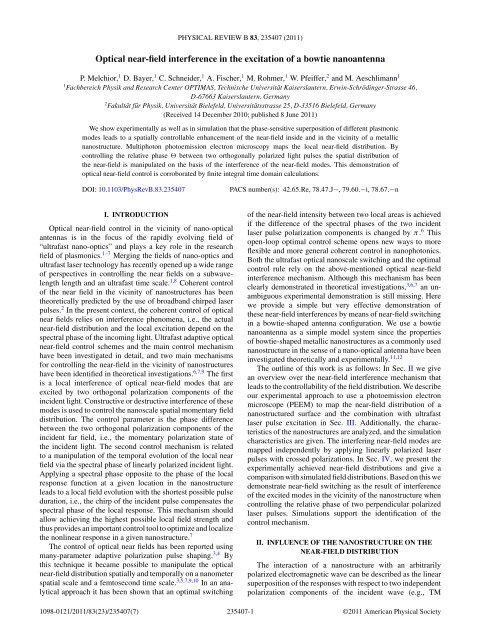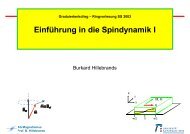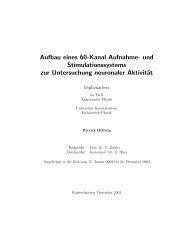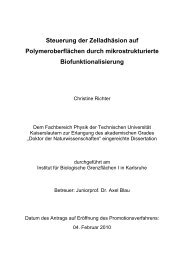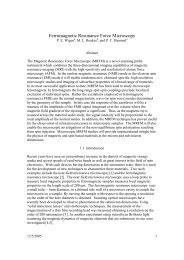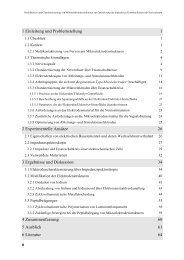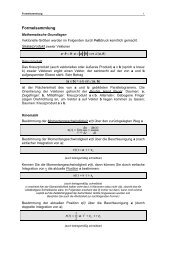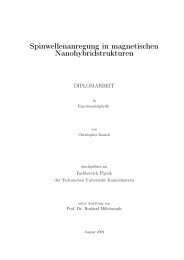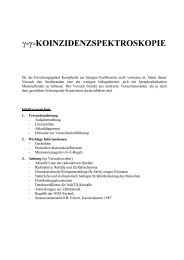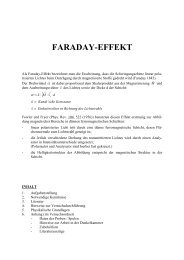Optical near-field interference in the excitation of a bowtie ...
Optical near-field interference in the excitation of a bowtie ...
Optical near-field interference in the excitation of a bowtie ...
You also want an ePaper? Increase the reach of your titles
YUMPU automatically turns print PDFs into web optimized ePapers that Google loves.
PHYSICAL REVIEW B 83, 235407 (2011)<br />
<strong>Optical</strong> <strong>near</strong>-<strong>field</strong> <strong><strong>in</strong>terference</strong> <strong>in</strong> <strong>the</strong> <strong>excitation</strong> <strong>of</strong> a <strong>bowtie</strong> nanoantenna<br />
P. Melchior, 1 D. Bayer, 1 C. Schneider, 1 A. Fischer, 1 M. Rohmer, 1 W. Pfeiffer, 2 and M. Aeschlimann 1<br />
1 Fachbereich Physik and Research Center OPTIMAS, Technische Universität Kaiserslautern, Erw<strong>in</strong>-Schröd<strong>in</strong>ger-Strasse 46,<br />
D-67663 Kaiserslautern, Germany<br />
2 Fakultät für Physik, Universität Bielefeld, Universitätsstrasse 25, D-33516 Bielefeld, Germany<br />
(Received 14 December 2010; published 8 June 2011)<br />
We show experimentally as well as <strong>in</strong> simulation that <strong>the</strong> phase-sensitive superposition <strong>of</strong> different plasmonic<br />
modes leads to a spatially controllable enhancement <strong>of</strong> <strong>the</strong> <strong>near</strong>-<strong>field</strong> <strong>in</strong>side and <strong>in</strong> <strong>the</strong> vic<strong>in</strong>ity <strong>of</strong> a metallic<br />
nanostructure. Multiphoton photoemission electron microscopy maps <strong>the</strong> local <strong>near</strong>-<strong>field</strong> distribution. By<br />
controll<strong>in</strong>g <strong>the</strong> relative phase between two orthogonally polarized light pulses <strong>the</strong> spatial distribution <strong>of</strong><br />
<strong>the</strong> <strong>near</strong>-<strong>field</strong> is manipulated on <strong>the</strong> basis <strong>of</strong> <strong>the</strong> <strong><strong>in</strong>terference</strong> <strong>of</strong> <strong>the</strong> <strong>near</strong>-<strong>field</strong> modes. This demonstration <strong>of</strong><br />
optical <strong>near</strong>-<strong>field</strong> control is corroborated by f<strong>in</strong>ite <strong>in</strong>tegral time doma<strong>in</strong> calculations.<br />
DOI: 10.1103/PhysRevB.83.235407<br />
PACS number(s): 42.65.Re, 78.47.J−,79.60.−i, 78.67.−n<br />
I. INTRODUCTION<br />
<strong>Optical</strong> <strong>near</strong>-<strong>field</strong> control <strong>in</strong> <strong>the</strong> vic<strong>in</strong>ity <strong>of</strong> nano-optical<br />
antennas is <strong>in</strong> <strong>the</strong> focus <strong>of</strong> <strong>the</strong> rapidly evolv<strong>in</strong>g <strong>field</strong> <strong>of</strong><br />
“ultrafast nano-optics” and plays a key role <strong>in</strong> <strong>the</strong> research<br />
<strong>field</strong> <strong>of</strong> plasmonics. 1–7 Merg<strong>in</strong>g <strong>the</strong> <strong>field</strong>s <strong>of</strong> nano-optics and<br />
ultrafast laser technology has recently opened up a wide range<br />
<strong>of</strong> perspectives <strong>in</strong> controll<strong>in</strong>g <strong>the</strong> <strong>near</strong> <strong>field</strong>s on a subwavelength<br />
length and an ultrafast time scale. 1,8 Coherent control<br />
<strong>of</strong> <strong>the</strong> <strong>near</strong> <strong>field</strong> <strong>in</strong> <strong>the</strong> vic<strong>in</strong>ity <strong>of</strong> nanostructures has been<br />
<strong>the</strong>oretically predicted by <strong>the</strong> use <strong>of</strong> broadband chirped laser<br />
pulses. 2 In <strong>the</strong> present context, <strong>the</strong> coherent control <strong>of</strong> optical<br />
<strong>near</strong> <strong>field</strong>s relies on <strong><strong>in</strong>terference</strong> phenomena, i.e., <strong>the</strong> actual<br />
<strong>near</strong>-<strong>field</strong> distribution and <strong>the</strong> local <strong>excitation</strong> depend on <strong>the</strong><br />
spectral phase <strong>of</strong> <strong>the</strong> <strong>in</strong>com<strong>in</strong>g light. Ultrafast adaptive optical<br />
<strong>near</strong>-<strong>field</strong> control schemes and <strong>the</strong> ma<strong>in</strong> control mechanism<br />
have been <strong>in</strong>vestigated <strong>in</strong> detail, and two ma<strong>in</strong> mechanisms<br />
for controll<strong>in</strong>g <strong>the</strong> <strong>near</strong>-<strong>field</strong> <strong>in</strong> <strong>the</strong> vic<strong>in</strong>ity <strong>of</strong> nanostructures<br />
have been identified <strong>in</strong> <strong>the</strong>oretical <strong>in</strong>vestigations. 6,7,9 The first<br />
is a local <strong><strong>in</strong>terference</strong> <strong>of</strong> optical <strong>near</strong>-<strong>field</strong> modes that are<br />
excited by two orthogonal polarization components <strong>of</strong> <strong>the</strong><br />
<strong>in</strong>cident light. Constructive or destructive <strong><strong>in</strong>terference</strong> <strong>of</strong> <strong>the</strong>se<br />
modes is used to control <strong>the</strong> nanoscale spatial momentary <strong>field</strong><br />
distribution. The control parameter is <strong>the</strong> phase difference<br />
between <strong>the</strong> two orthogonal polarization components <strong>of</strong> <strong>the</strong><br />
<strong>in</strong>cident far <strong>field</strong>, i.e., <strong>the</strong> momentary polarization state <strong>of</strong><br />
<strong>the</strong> <strong>in</strong>cident light. The second control mechanism is related<br />
to a manipulation <strong>of</strong> <strong>the</strong> temporal evolution <strong>of</strong> <strong>the</strong> local <strong>near</strong><br />
<strong>field</strong> via <strong>the</strong> spectral phase <strong>of</strong> li<strong>near</strong>ly polarized <strong>in</strong>cident light.<br />
Apply<strong>in</strong>g a spectral phase opposite to <strong>the</strong> phase <strong>of</strong> <strong>the</strong> local<br />
response function at a given location <strong>in</strong> <strong>the</strong> nanostructure<br />
leads to a local <strong>field</strong> evolution with <strong>the</strong> shortest possible pulse<br />
duration, i.e., <strong>the</strong> chirp <strong>of</strong> <strong>the</strong> <strong>in</strong>cident pulse compensates <strong>the</strong><br />
spectral phase <strong>of</strong> <strong>the</strong> local response. This mechanism should<br />
allow achiev<strong>in</strong>g <strong>the</strong> highest possible local <strong>field</strong> strength and<br />
thus provides an important control tool to optimize and localize<br />
<strong>the</strong> nonli<strong>near</strong> response <strong>in</strong> a given nanostructure. 7<br />
The control <strong>of</strong> optical <strong>near</strong> <strong>field</strong>s has been reported us<strong>in</strong>g<br />
many-parameter adaptive polarization pulse shap<strong>in</strong>g. 3,4 By<br />
this technique it became possible to manipulate <strong>the</strong> optical<br />
<strong>near</strong>-<strong>field</strong> distribution spatially and temporally on a nanometer<br />
spatial scale and a femtosecond time scale. 3,5,7,9,10 In an analytical<br />
approach it has been shown that an optimal switch<strong>in</strong>g<br />
<strong>of</strong> <strong>the</strong> <strong>near</strong>-<strong>field</strong> <strong>in</strong>tensity between two local areas is achieved<br />
if <strong>the</strong> difference <strong>of</strong> <strong>the</strong> spectral phases <strong>of</strong> <strong>the</strong> two <strong>in</strong>cident<br />
laser pulse polarization components is changed by π. 6 This<br />
open-loop optimal control scheme opens new ways to more<br />
flexible and more general coherent control <strong>in</strong> nanophotonics.<br />
Both <strong>the</strong> ultrafast optical nanoscale switch<strong>in</strong>g and <strong>the</strong> optimal<br />
control rule rely on <strong>the</strong> above-mentioned optical <strong>near</strong>-<strong>field</strong><br />
<strong><strong>in</strong>terference</strong> mechanism. Although this mechanism has been<br />
clearly demonstrated <strong>in</strong> <strong>the</strong>oretical <strong>in</strong>vestigations, 3,6,7 an unambiguous<br />
experimental demonstration is still miss<strong>in</strong>g. Here<br />
we provide a simple but very effective demonstration <strong>of</strong><br />
<strong>the</strong>se <strong>near</strong>-<strong>field</strong> <strong><strong>in</strong>terference</strong>s by means <strong>of</strong> <strong>near</strong>-<strong>field</strong> switch<strong>in</strong>g<br />
<strong>in</strong> a <strong>bowtie</strong>-shaped antenna configuration. We use a <strong>bowtie</strong><br />
nanoantenna as a simple model system s<strong>in</strong>ce <strong>the</strong> properties<br />
<strong>of</strong> <strong>bowtie</strong>-shaped metallic nanostructures as a commonly used<br />
nanostructure <strong>in</strong> <strong>the</strong> sense <strong>of</strong> a nano-optical antenna have been<br />
<strong>in</strong>vestigated <strong>the</strong>oretically and experimentally. 11,12<br />
The outl<strong>in</strong>e <strong>of</strong> this work is as follows: In Sec. II we give<br />
an overview over <strong>the</strong> <strong>near</strong>-<strong>field</strong> <strong><strong>in</strong>terference</strong> mechanism that<br />
leads to <strong>the</strong> controllability <strong>of</strong> <strong>the</strong> <strong>field</strong> distribution. We describe<br />
our experimental approach to use a photoemission electron<br />
microscope (PEEM) to map <strong>the</strong> <strong>near</strong>-<strong>field</strong> distribution <strong>of</strong> a<br />
nanostructured surface and <strong>the</strong> comb<strong>in</strong>ation with ultrafast<br />
laser pulse <strong>excitation</strong> <strong>in</strong> Sec. III. Additionally, <strong>the</strong> characteristics<br />
<strong>of</strong> <strong>the</strong> nanostructures are analyzed, and <strong>the</strong> simulation<br />
characteristics are given. The <strong>in</strong>terfer<strong>in</strong>g <strong>near</strong>-<strong>field</strong> modes are<br />
mapped <strong>in</strong>dependently by apply<strong>in</strong>g li<strong>near</strong>ly polarized laser<br />
pulses with crossed polarizations. In Sec. IV, we present <strong>the</strong><br />
experimentally achieved <strong>near</strong>-<strong>field</strong> distributions and give a<br />
comparison with simulated <strong>field</strong> distributions. Based on this we<br />
demonstrate <strong>near</strong>-<strong>field</strong> switch<strong>in</strong>g as <strong>the</strong> result <strong>of</strong> <strong><strong>in</strong>terference</strong><br />
<strong>of</strong> <strong>the</strong> excited modes <strong>in</strong> <strong>the</strong> vic<strong>in</strong>ity <strong>of</strong> <strong>the</strong> nanostructure when<br />
controll<strong>in</strong>g <strong>the</strong> relative phase <strong>of</strong> two perpendicular polarized<br />
laser pulses. Simulations support <strong>the</strong> identification <strong>of</strong> <strong>the</strong><br />
control mechanism.<br />
II. INFLUENCE OF THE NANOSTRUCTURE ON THE<br />
NEAR-FIELD DISTRIBUTION<br />
The <strong>in</strong>teraction <strong>of</strong> a nanostructure with an arbitrarily<br />
polarized electromagnetic wave can be described as <strong>the</strong> li<strong>near</strong><br />
superposition <strong>of</strong> <strong>the</strong> responses with respect to two <strong>in</strong>dependent<br />
polarization components <strong>of</strong> <strong>the</strong> <strong>in</strong>cident wave (e.g., TM<br />
1098-0121/2011/83(23)/235407(7) 235407-1<br />
©2011 American Physical Society
P. MELCHIOR et al. PHYSICAL REVIEW B 83, 235407 (2011)<br />
TE<br />
E TE<br />
far-<strong>field</strong><br />
65°<br />
TM<br />
E TM n<br />
PEEM<br />
<strong>near</strong>-<strong>field</strong><br />
E loc<br />
E loc,TE<br />
E loc,TM<br />
r<br />
E‘ loc<br />
E‘ loc,TE<br />
FIG. 1. (Color onl<strong>in</strong>e) Schematic <strong>of</strong> <strong>the</strong> experimental setup and<br />
<strong>the</strong> <strong>near</strong>-<strong>field</strong> <strong><strong>in</strong>terference</strong> mechanism. The local <strong>field</strong>s E loc,TE and<br />
E loc,TM generated by <strong>the</strong> TE and TM far-<strong>field</strong> components are no<br />
longer orthogonal.<br />
and TE) because <strong>of</strong> <strong>the</strong> li<strong>near</strong>ity <strong>of</strong> Maxwell’s <strong>the</strong>ory. 3 The<br />
propagat<strong>in</strong>g far-<strong>field</strong> components drive <strong>the</strong> li<strong>near</strong> polarization<br />
P i (r,ω) = G i (r,ω)E ext,i (r,ω), which can be described by <strong>the</strong><br />
space- and frequency-dependent li<strong>near</strong> local response G i (r,ω),<br />
with i = TM, TE. The effective <strong>near</strong>-<strong>field</strong> results from <strong>the</strong><br />
superposition <strong>of</strong> <strong>the</strong> <strong>in</strong>duced polarization with <strong>the</strong> <strong>in</strong>com<strong>in</strong>g<br />
light <strong>field</strong> E loc,i (r,ω) = [1 + G i (r,ω)] E ext,i (ω). Note that <strong>the</strong><br />
<strong>field</strong> components are complex valued and thus conta<strong>in</strong> spectral<br />
amplitude and phase for each polarization component. The<br />
phase between <strong>the</strong> two polarization components E ext,TM (ω)<br />
and E ext,TE (ω) does not affect <strong>the</strong> far-<strong>field</strong> <strong>in</strong>tensity distribution<br />
s<strong>in</strong>ce both components are orthogonal and thus do not <strong>in</strong>terfere.<br />
The local <strong>field</strong>s generated by <strong>the</strong> two polarization components<br />
are, <strong>in</strong> general, no longer perpendicular to each o<strong>the</strong>r, and thus,<br />
<strong><strong>in</strong>terference</strong> effects between both <strong>field</strong>s <strong>in</strong>fluence <strong>the</strong> optical<br />
<strong>near</strong>-<strong>field</strong> distribution <strong>in</strong> <strong>the</strong> vic<strong>in</strong>ity <strong>of</strong> <strong>the</strong> nanostructures.<br />
The local <strong>near</strong>-<strong>field</strong> <strong>in</strong>tensity distribution I loc<br />
(r,ω) <strong>in</strong>cludes<br />
an <strong><strong>in</strong>terference</strong> term that gives <strong>the</strong> freedom to control <strong>the</strong><br />
<strong>near</strong>-<strong>field</strong> distribution via <strong>the</strong> phase difference <strong>of</strong> <strong>the</strong> two<br />
fundamental polarization components. Omitt<strong>in</strong>g for simplicity<br />
<strong>the</strong> role <strong>of</strong> <strong>the</strong> local magnetic <strong>field</strong>, <strong>the</strong> proportionality <strong>of</strong> <strong>the</strong><br />
local <strong>in</strong>tensity to <strong>the</strong> local <strong>field</strong> components is given by 6<br />
I loc (r,ω) ∝|E loc,TM (r,ω)| 2 +|E loc,TE (r,ω)| 2<br />
+ 2 E loc,TE (r,ω) · E loc,TM (r,ω). (1)<br />
Figure 1 sketches <strong>the</strong> correspond<strong>in</strong>g <strong>near</strong>-<strong>field</strong> control<br />
mechanism. The local optical <strong>near</strong>-<strong>field</strong> E loc (r,ω) at <strong>the</strong><br />
position r is given by <strong>the</strong> superposition <strong>of</strong> <strong>the</strong> <strong>in</strong>cident light<br />
<strong>field</strong> and <strong>the</strong> <strong>in</strong>duced polarization <strong>field</strong>s. Treat<strong>in</strong>g both TM<br />
and TE components separately, <strong>the</strong> local <strong>field</strong> E loc (r,ω) is<br />
determ<strong>in</strong>ed by <strong>the</strong> relative phase difference = ϕ TE − ϕ TM<br />
between <strong>the</strong>m. This means that <strong>the</strong> polarization state <strong>of</strong><br />
<strong>the</strong> <strong>in</strong>cident light determ<strong>in</strong>es <strong>the</strong> local <strong>field</strong>. The local <strong>field</strong><br />
component Eloc,i α (r,ω), with α ∈ {x,y,z} , for a given li<strong>near</strong>ly<br />
polarized <strong>in</strong>cident light at one location r for one frequency ω<br />
is given as a complex number,<br />
E α loc,i (r,ω) ∝ ∣ ∣ E<br />
α<br />
loc,i (r,ω) ∣ ∣ exp [iϕi (r,ω)] , (2)<br />
where i denotes <strong>the</strong> <strong>excitation</strong> polarization TM or TE. The<br />
superposition <strong>of</strong> <strong>the</strong> local <strong>field</strong>s to calculate <strong>the</strong> result<strong>in</strong>g<br />
<strong>in</strong>tensity distribution when two <strong>in</strong>dependent polarizations are<br />
used for <strong>excitation</strong> can <strong>the</strong>n be expressed us<strong>in</strong>g <strong>the</strong> relative<br />
phase . The local electric <strong>field</strong> components are <strong>the</strong>n given by<br />
Eloc α (r,ω) = ∣ E<br />
α<br />
loc,TM (r,ω) ∣ exp[i ϕTM (r,ω)]<br />
+ ∣ E<br />
α<br />
loc,TE (r,ω) ∣ exp[i ϕTE (r,ω)] exp(i ). (3)<br />
A variation <strong>of</strong> <strong>the</strong> relative phase by corresponds to a<br />
phase retardation <strong>of</strong> one <strong>of</strong> <strong>the</strong> <strong>field</strong>s relative to <strong>the</strong> o<strong>the</strong>r one<br />
and is realized <strong>in</strong> <strong>the</strong> experiment by a change <strong>of</strong> <strong>the</strong> optical<br />
delay between two orthogonal polarized laser pulses. Note that<br />
<strong>the</strong> <strong>in</strong>troduced phase difference is not constant over <strong>the</strong> laser<br />
spectrum but shows a li<strong>near</strong> spectral dependence because <strong>of</strong> <strong>the</strong><br />
different <strong>in</strong>volved frequencies. However, <strong>in</strong> <strong>the</strong> present case,<br />
this <strong>in</strong>fluence can be neglected <strong>in</strong> first-order approximation.<br />
Constructive versus destructive <strong><strong>in</strong>terference</strong> <strong>of</strong> <strong>the</strong> local <strong>field</strong>s<br />
as <strong>the</strong> phase between <strong>the</strong> <strong>in</strong>com<strong>in</strong>g <strong>field</strong>s is changed gives a<br />
handle to control <strong>the</strong> spatial optical <strong>near</strong>-<strong>field</strong> distribution. 5,10<br />
Theoretically, <strong>the</strong> full <strong>in</strong>formation about <strong>the</strong> response function<br />
<strong>of</strong> a nanostructure is already present if <strong>the</strong> response <strong>of</strong> <strong>the</strong><br />
nanostructure to two orthogonal polarization states <strong>of</strong> <strong>the</strong><br />
excit<strong>in</strong>g light is known. All k<strong>in</strong>ds <strong>of</strong> polarization-dependent<br />
effects <strong>of</strong> <strong>the</strong> structure can <strong>the</strong>n easily be calculated accord<strong>in</strong>g<br />
to Eq. (3) or generated with <strong>the</strong> coherent superposition <strong>of</strong> <strong>the</strong><br />
two <strong>in</strong>dependent polarization states. 7<br />
III. METHODS AND NANOSTRUCTURE<br />
CHARACTERIZATION<br />
A. Photoemission microscopy as a <strong>near</strong>-<strong>field</strong> probe<br />
The <strong>in</strong>vestigation <strong>of</strong> nano-optical antennas with tailored designs<br />
requires a non<strong>in</strong>vasive and versatile technique to map <strong>the</strong><br />
<strong>near</strong>-<strong>field</strong> distribution with a sufficiently high spatial resolution<br />
and <strong>the</strong> possibility to resolve <strong>the</strong> temporal evolution <strong>of</strong> <strong>the</strong><br />
optical <strong>near</strong>-<strong>field</strong> distribution and nanophotonic <strong>excitation</strong>s. It<br />
has been shown that PEEM is a suitable tool to <strong>in</strong>vestigate <strong>the</strong><br />
<strong>near</strong> <strong>field</strong>s around nanostructures and <strong>the</strong>ir electronic as well<br />
as plasmonic properties. 13,14<br />
Plasmonic resonances <strong>of</strong> nanostructures made <strong>of</strong> gold or<br />
silver lie <strong>in</strong> <strong>the</strong> visible spectral range. Therefore, <strong>the</strong> photon<br />
energy <strong>of</strong> <strong>the</strong> correspond<strong>in</strong>g resonance is smaller than <strong>the</strong><br />
work function <strong>of</strong> gold used here as nanostructure material.<br />
lies, depend<strong>in</strong>g on <strong>the</strong> surface conditions, at about =<br />
4.7–5.1 eV. 15,16 With a photon energy <strong>of</strong> hν = 1.55 eV a<br />
nonli<strong>near</strong> photoemission process is necessary to overcome<br />
<strong>the</strong> work function <strong>of</strong> <strong>the</strong> material. In <strong>the</strong> simplest model for<br />
multiphoton photoemission neglect<strong>in</strong>g details <strong>of</strong> <strong>the</strong> material<br />
band structure, <strong>in</strong>termediate state lifetimes, and f<strong>in</strong>al state<br />
effects, <strong>the</strong> yield is proportional to <strong>the</strong> 2nth power <strong>of</strong> <strong>the</strong> local<br />
electric <strong>field</strong> E loc<br />
(r,ω), where n is <strong>the</strong> order <strong>of</strong> nonli<strong>near</strong>ity.<br />
Hence, while <strong>the</strong> plasmon <strong>excitation</strong> or, more generally, <strong>the</strong><br />
optical response <strong>of</strong> <strong>the</strong> nanostructure is still <strong>in</strong> <strong>the</strong> li<strong>near</strong><br />
regime, <strong>the</strong> detected photoemission signal is <strong>the</strong> result <strong>of</strong> a<br />
nonli<strong>near</strong> process. 17 By this <strong>the</strong> local <strong>near</strong>-<strong>field</strong> <strong>in</strong>tensity is<br />
enhanced nonli<strong>near</strong>ly. The higher <strong>the</strong> order <strong>of</strong> <strong>the</strong> process is,<br />
<strong>the</strong> more sensitively <strong>the</strong> signal reacts to small variations <strong>in</strong> <strong>the</strong><br />
<strong>near</strong>-<strong>field</strong> <strong>in</strong>tensity.<br />
235407-2
OPTICAL NEAR-FIELD INTERFERENCE IN THE ... PHYSICAL REVIEW B 83, 235407 (2011)<br />
B. The experimental setup<br />
The experiments are performed with a photoemission<br />
electron microscope based on an electrostatic lens system<br />
(Focus IS PEEM) with a spatial resolution <strong>of</strong>
P. MELCHIOR et al. PHYSICAL REVIEW B 83, 235407 (2011)<br />
Relative Field Amplitude<br />
2.5<br />
2.0<br />
1.5<br />
1.0<br />
0.5<br />
700 750 800 850 900 950 1000<br />
Wavelength [nm]<br />
upper corner<br />
lower corner<br />
gap<br />
corner TM z-comp<br />
corner TE z-comp<br />
gap TM<br />
Laser spectrum<br />
FIG. 3. (Color onl<strong>in</strong>e) Simulated <strong>near</strong>-<strong>field</strong> response (z component)<br />
recorded at a s<strong>in</strong>gle corner <strong>of</strong> <strong>the</strong> left nanoprism for TE (red<br />
dashed l<strong>in</strong>e) and TM (black dash dotted l<strong>in</strong>e) polarized <strong>excitation</strong> <strong>of</strong><br />
a <strong>bowtie</strong> nanoantenna. The blue dotted l<strong>in</strong>e shows <strong>the</strong> response at<br />
<strong>the</strong> gap corner <strong>of</strong> <strong>the</strong> right nanoprism. The shadowed area shows <strong>the</strong><br />
bandwidth (FWHM) <strong>of</strong> <strong>the</strong> laser pulses used with a maximum at λ =<br />
795 nm (yellow solid l<strong>in</strong>e). The <strong>in</strong>set sketches <strong>the</strong> po<strong>in</strong>ts <strong>of</strong> <strong>in</strong>terest.<br />
<strong>in</strong>side <strong>the</strong> metal as only <strong>the</strong> <strong>in</strong>ternal <strong>field</strong> is relevant for <strong>the</strong><br />
photo<strong>excitation</strong> <strong>in</strong>to <strong>in</strong>termediate bound states and thus also<br />
dom<strong>in</strong>ates <strong>the</strong> multiphoton photoemission process. We focus<br />
our <strong>in</strong>vestigation <strong>in</strong> this work on <strong>the</strong> <strong>near</strong>-<strong>field</strong> <strong><strong>in</strong>terference</strong><br />
and show <strong>the</strong>refore <strong>in</strong> Fig. 3 <strong>the</strong> local response only at <strong>the</strong><br />
outer corner <strong>of</strong> <strong>the</strong> <strong>bowtie</strong> structure where we present <strong>the</strong><br />
<strong><strong>in</strong>terference</strong> effect later on.<br />
The local <strong>field</strong> components Eloc,i α (r,ω), with α ∈ {x,y,z},<br />
as derived from <strong>the</strong> FIM calculations for TM- and TE-polarized<br />
illum<strong>in</strong>ation are composed like <strong>in</strong> Eq. (3) to simulate a<br />
simultaneous <strong>excitation</strong> with TM and TE polarization. The<br />
<strong>in</strong>fluence <strong>of</strong> <strong>the</strong> <strong><strong>in</strong>terference</strong> term [<strong>the</strong> term on <strong>the</strong> right-hand<br />
side <strong>of</strong> Eq. (1)] is <strong>in</strong>vestigated by a variation <strong>of</strong> <strong>the</strong> phase<br />
difference between <strong>the</strong> two <strong>in</strong>dependent <strong>excitation</strong> <strong>field</strong>s, as<br />
will be discussed <strong>in</strong> detail <strong>in</strong> Sec. IV C.<br />
IV. RESULTS AND DISCUSSION<br />
A. Near-<strong>field</strong> modes: Experiments<br />
Apply<strong>in</strong>g a femtosecond laser pulse to <strong>the</strong> nanostructure<br />
as shown <strong>in</strong> Fig. 2 with a photon energy <strong>of</strong> hν = 1.55 eV, a<br />
hot-spot-like photoemission pattern is observed [see Figs. 4(b)<br />
and 4(c)]. The emission pattern no longer follows <strong>the</strong> shape<br />
<strong>of</strong> <strong>the</strong> nanoantenna but is now localized <strong>in</strong> dist<strong>in</strong>ct regions<br />
<strong>of</strong> <strong>the</strong> structure depend<strong>in</strong>g on <strong>the</strong> polarization state <strong>of</strong> <strong>the</strong><br />
<strong>in</strong>cident light. Note that <strong>the</strong> comparison with 1PPE images<br />
[see Fig. 4(a)] obta<strong>in</strong>ed under UV <strong>excitation</strong> and <strong>the</strong> identical<br />
sett<strong>in</strong>gs <strong>of</strong> <strong>the</strong> PEEM apparatus allows determ<strong>in</strong><strong>in</strong>g <strong>the</strong><br />
exact position <strong>of</strong> <strong>the</strong> hot-spot photoemission on <strong>the</strong> structure<br />
(outl<strong>in</strong>es <strong>in</strong> Fig. 4).<br />
For TM-polarized <strong>excitation</strong> an emission maximum <strong>in</strong> <strong>the</strong><br />
gap region is clearly resolved [Fig. 4(b)]. The unambiguously<br />
located nanostructure outl<strong>in</strong>e <strong>in</strong> this emission pattern shows<br />
that <strong>the</strong> emission maximum is centered at <strong>the</strong> tip <strong>of</strong> <strong>the</strong><br />
right nanoprism ra<strong>the</strong>r than <strong>in</strong> <strong>the</strong> middle <strong>of</strong> <strong>the</strong> gap. In<br />
(a)<br />
(b)<br />
(c)<br />
350 nm<br />
TM<br />
k ||<br />
TE<br />
k ||<br />
>200<br />
160<br />
120<br />
80<br />
40<br />
20<br />
0<br />
>130<br />
120<br />
100<br />
80<br />
60<br />
40<br />
20<br />
0<br />
>130<br />
120<br />
100<br />
80<br />
60<br />
40<br />
20<br />
0<br />
FIG. 4. Photoemission pattern from <strong>the</strong> <strong>bowtie</strong> antenna. (a) 1PPE<br />
pattern (<strong>of</strong>f-resonant) obta<strong>in</strong>ed under UV <strong>excitation</strong> us<strong>in</strong>g a mercury<br />
lamp. (b) 3PPE pattern under TM-polarized laser pulse <strong>excitation</strong><br />
reveals strong photoemission from <strong>the</strong> antenna gap and a weak<br />
photoemission at <strong>the</strong> corners <strong>of</strong> <strong>the</strong> left nanoprism. (c) 3PPE pattern<br />
under TE-polarized laser pulse <strong>excitation</strong> shows weak photoemission<br />
from <strong>the</strong> corners <strong>of</strong> <strong>the</strong> left nanoprism. The laser beam comes from<br />
<strong>the</strong> right side and is <strong>in</strong>dicated by <strong>the</strong> parallel k vector component k ‖ .<br />
addition to this strong “gap emission” <strong>in</strong> Fig. 4(b), smaller<br />
emission maxima appear at <strong>the</strong> outer corners <strong>of</strong> <strong>the</strong> triangular<br />
nanoprisms. Interest<strong>in</strong>gly, <strong>the</strong>se weak photoemission maxima<br />
appear at <strong>the</strong> left nanoprism only. This asymmetry is attributed<br />
to <strong>the</strong> non-normal illum<strong>in</strong>ation condition, i.e., <strong>the</strong> parallel<br />
component k ‖ <strong>of</strong> <strong>the</strong> <strong>in</strong>cident light is directed toward <strong>the</strong> left.<br />
Due to <strong>the</strong> non-normal <strong>in</strong>cidence <strong>of</strong> <strong>the</strong> light and <strong>the</strong> size <strong>of</strong><br />
<strong>the</strong> structure, which is <strong>in</strong> <strong>the</strong> order <strong>of</strong> one wavelength <strong>of</strong> <strong>the</strong><br />
light, <strong>the</strong> response <strong>of</strong> <strong>the</strong> nanostructure is <strong>in</strong>fluenced by <strong>the</strong><br />
retardation effect.<br />
Under TE <strong>excitation</strong> [Fig. 4(c)] <strong>the</strong> emission pattern <strong>of</strong><br />
<strong>the</strong> nanoantenna changes significantly. The gap area <strong>of</strong> <strong>the</strong><br />
<strong>bowtie</strong> structure exhibits no emission. Only <strong>the</strong> upper and<br />
lower corners <strong>of</strong> <strong>the</strong> left triangular nanoprism appear to be<br />
weakly pronounced. The yield at <strong>the</strong> corners <strong>of</strong> <strong>the</strong> left<br />
nanoprism is under TE <strong>excitation</strong> with <strong>the</strong> same laser <strong>in</strong>tensity<br />
about ten times weaker than for TM <strong>excitation</strong>. The <strong>in</strong>tensity<br />
dependence <strong>of</strong> <strong>the</strong> total photoemission yield <strong>in</strong>dicates that at<br />
least a three-photon process is responsible for <strong>the</strong> detected<br />
emission, i.e., <strong>the</strong> yield scales with <strong>the</strong> sixth power <strong>of</strong> <strong>the</strong><br />
electric <strong>field</strong>. Therefore, <strong>the</strong> electric <strong>field</strong>s at <strong>the</strong> corners <strong>of</strong> <strong>the</strong><br />
left nanoprisms are still <strong>of</strong> <strong>the</strong> same magnitude, although we<br />
observe a strong difference <strong>in</strong> <strong>the</strong> photoemission signal.<br />
235407-4
OPTICAL NEAR-FIELD INTERFERENCE IN THE ... PHYSICAL REVIEW B 83, 235407 (2011)<br />
(a)<br />
(c)<br />
(e)<br />
100 nm<br />
100 nm<br />
100 nm<br />
TM<br />
k ||<br />
0 1 2 3 4 5 6 7 8 9<br />
TE<br />
TM<br />
k ||<br />
0 1 2 3 4 5 6 7 8 9<br />
k ||<br />
(b)<br />
(d)<br />
(f )<br />
100 nm<br />
100 nm<br />
100 nm<br />
TM<br />
TE<br />
TE<br />
0 1 2 5 10 20 40 100<br />
[V/m]<br />
[V/m]<br />
k ||<br />
k ||<br />
k ||<br />
x10 3 [V/m] 6<br />
FIG. 5. (Color) Simulated <strong>field</strong> distribution on <strong>the</strong> surface <strong>of</strong> <strong>the</strong><br />
gold nanostructure at a wavelength <strong>of</strong> λ = 795 nm. The illum<strong>in</strong>ation<br />
geometry is as <strong>in</strong> Fig. 1, with <strong>the</strong> light com<strong>in</strong>g from <strong>the</strong> right side<br />
as <strong>in</strong>dicated by <strong>the</strong> arrow denoted with k || . (a) Relative amplitude<br />
<strong>of</strong> <strong>the</strong> local electric <strong>field</strong> and (b) its z component for TM-polarized<br />
illum<strong>in</strong>ation. (c) and (d) Relative amplitude and z component for<br />
TE-polarized illum<strong>in</strong>ation. (e) and (f) Sixth power <strong>of</strong> <strong>the</strong> simulated<br />
<strong>field</strong> (E z component) <strong>in</strong> logarithmic scale to qualitatively compare <strong>the</strong><br />
distribution with PEEM images from a 3PPE process. The <strong>in</strong>cident<br />
<strong>field</strong> has an amplitude <strong>of</strong> 1 V/m.<br />
For <strong>the</strong> follow<strong>in</strong>g discussion it should be emphasized that<br />
<strong>the</strong>re is no obvious difference <strong>in</strong> <strong>the</strong> photoemission yield<br />
between <strong>the</strong> upper and <strong>the</strong> lower outer corners <strong>of</strong> <strong>the</strong> left<br />
nanoprism. For purely li<strong>near</strong> polarized TM or TE light this<br />
behavior is fully expected because <strong>of</strong> <strong>the</strong> symmetry <strong>of</strong> <strong>the</strong><br />
nanostructure. As will be shown later <strong>in</strong> this work (see<br />
Sec. IV C), this changes dramatically when <strong>the</strong> <strong>excitation</strong> <strong>field</strong><br />
simultaneously conta<strong>in</strong>s TM and TE components.<br />
B. Near-<strong>field</strong> modes: Simulations<br />
Figure 5 shows <strong>the</strong> calculated <strong>field</strong> amplitude on <strong>the</strong> surface<br />
<strong>of</strong> <strong>the</strong> gold nanostructure for <strong>the</strong> wavelength <strong>of</strong> λ = 795 nm.<br />
The <strong>excitation</strong> light comes from <strong>the</strong> right side under an angle<br />
<strong>of</strong> 65 ◦ to <strong>the</strong> surface normal, where k || <strong>in</strong>dicates <strong>the</strong> vector<br />
component parallel to <strong>the</strong> surface. Figures 5(a) and 5(c) present<br />
<strong>the</strong> absolute value <strong>of</strong> <strong>the</strong> <strong>field</strong> for TM and TE <strong>excitation</strong>s. The<br />
<strong>field</strong> is dom<strong>in</strong>ated by <strong>the</strong> z component <strong>of</strong> <strong>the</strong> electric <strong>field</strong><br />
on <strong>the</strong> surface <strong>of</strong> <strong>the</strong> metallic structure proven <strong>in</strong> Figs. 5(b)<br />
and 5(d). The contour plots <strong>in</strong> Figs. 5(a)–5(d) are shown on<br />
<strong>the</strong> same li<strong>near</strong> scale. The direct comparison reflects that <strong>the</strong><br />
overall <strong>in</strong>duced <strong>field</strong> amplitude under TE-polarized <strong>excitation</strong><br />
is much weaker <strong>in</strong> <strong>the</strong> gap area <strong>of</strong> <strong>the</strong> <strong>bowtie</strong> structure and<br />
slightly weaker <strong>in</strong> <strong>the</strong> area around <strong>the</strong> edges as compared to<br />
TM <strong>excitation</strong>. For TM <strong>excitation</strong> [see Figs. 5(a) and 5(b)] a<br />
strong <strong>field</strong> enhancement occurs <strong>in</strong> <strong>the</strong> gap area <strong>of</strong> <strong>the</strong> <strong>bowtie</strong><br />
antenna and at <strong>the</strong> corners <strong>of</strong> <strong>the</strong> prisms. As can be seen<br />
from Fig. 3, <strong>the</strong> gap mode resonance has its maximum at a<br />
wavelength <strong>of</strong> 825 nm. The center wavelength <strong>of</strong> <strong>the</strong> laser pulse<br />
is <strong>the</strong>refore blue shifted to <strong>the</strong> structure resonance. The slightly<br />
<strong>of</strong>f-resonant <strong>excitation</strong> <strong>of</strong> this mode leads only to a moderate<br />
<strong>field</strong> enhancement, and thus, <strong>the</strong> effects <strong>of</strong> <strong>the</strong> corner and edge<br />
modes can still be resolved <strong>in</strong> <strong>the</strong> multiphoton photoemission<br />
pattern. Figures 5(c) and 5(d) show <strong>the</strong> spatial distribution<br />
for <strong>the</strong> total electric <strong>field</strong> strength and its z component <strong>in</strong> <strong>the</strong><br />
case <strong>of</strong> TE-polarized <strong>excitation</strong>. In contrast to a TM-polarized<br />
<strong>excitation</strong>, <strong>the</strong> structure does not show a clear resonance peak<br />
<strong>in</strong> <strong>the</strong> response function for TE polarization but is ra<strong>the</strong>r flat<br />
<strong>in</strong> <strong>the</strong> <strong>in</strong>terest<strong>in</strong>g wavelength range (compare Fig. 3).<br />
To qualitatively compare <strong>the</strong> calculation with <strong>the</strong> PEEM<br />
results, it is necessary to consider <strong>the</strong> nonli<strong>near</strong>ity <strong>of</strong> <strong>the</strong> 3PPE<br />
process. Figures 5(e) and 5(f) show <strong>the</strong>refore <strong>the</strong> sixth power<br />
<strong>of</strong> <strong>the</strong> calculated electric <strong>field</strong> (E z component) and thus should<br />
correspond qualitatively to <strong>the</strong> emission pattern generated<br />
<strong>in</strong> a three-photon photoemission process. The spatial <strong>field</strong><br />
distributions <strong>in</strong> Fig. 5(e) and 5(f) are plotted on logarithmic<br />
scale as <strong>the</strong>y cover a huge dynamic range.<br />
The calculated distributions show good agreements with<br />
<strong>the</strong> PEEM patterns (compare Fig. 4). Figure 5(e) shows<br />
<strong>the</strong> simulated nonli<strong>near</strong> emission pattern for a TM-polarized<br />
<strong>excitation</strong>. The strong <strong>field</strong> <strong>in</strong> <strong>the</strong> gap area <strong>of</strong> <strong>the</strong> <strong>bowtie</strong><br />
structure is about one order <strong>of</strong> magnitude larger than at <strong>the</strong><br />
outer corners <strong>of</strong> <strong>the</strong> right nanoprism. The experimental PEEM<br />
pattern [see Fig. 4(b)] shows, <strong>in</strong> good agreement with that for<br />
TM polarization, a strong peak signal <strong>in</strong> <strong>the</strong> gap area located<br />
at <strong>the</strong> tip <strong>of</strong> <strong>the</strong> right nanoprism that is about a factor <strong>of</strong> 30<br />
higher than <strong>the</strong> two weak signal peaks at <strong>the</strong> outer corners <strong>of</strong><br />
<strong>the</strong> left nanoprism. In contrast to <strong>the</strong> simulated distributions,<br />
we do not see a photoemission from <strong>the</strong> basis edge on <strong>the</strong> left<br />
side and from <strong>the</strong> edges <strong>of</strong> <strong>the</strong> right prism.<br />
The calculated distribution for TE-polarized <strong>excitation</strong> [see<br />
Fig. 5(f)] is also <strong>in</strong> good agreement with <strong>the</strong> experimental data<br />
<strong>in</strong> Fig. 4(c). The measured photoemission signal is very small<br />
except for <strong>the</strong> outer corners <strong>of</strong> <strong>the</strong> left nanoprism. This is also<br />
seen <strong>in</strong> <strong>the</strong> calculated distribution, i.e., only <strong>the</strong> outer corners<br />
<strong>of</strong> <strong>the</strong> left prism show a pronounced <strong>field</strong>.<br />
C. <strong>Optical</strong> <strong>near</strong>-<strong>field</strong> mode <strong><strong>in</strong>terference</strong>s <strong>in</strong> <strong>bowtie</strong><br />
nanoantennas<br />
In <strong>the</strong> follow<strong>in</strong>g we show experimentally as well as <strong>in</strong><br />
simulation that <strong>the</strong> superposition <strong>of</strong> <strong>the</strong> <strong>near</strong> <strong>field</strong>s leads to<br />
a phase-sensitive <strong>in</strong>tensity distribution that is determ<strong>in</strong>ed by<br />
<strong>the</strong> <strong><strong>in</strong>terference</strong> term <strong>in</strong> <strong>the</strong> <strong>in</strong>tensity pr<strong>of</strong>ile. A Mach-Zehnder<br />
<strong>in</strong>terferometer is used to coherently superpose two laser pulses<br />
with cross-polarized electric <strong>field</strong>s as described above. Chang<strong>in</strong>g<br />
<strong>the</strong> optical path length <strong>of</strong> one <strong>of</strong> <strong>the</strong> beams on a nanometer<br />
scale corresponds to a relative phase shift between both pulses<br />
and thus also between <strong>the</strong> two polarization components. So <strong>the</strong><br />
actual polarization state <strong>of</strong> <strong>the</strong> <strong>in</strong>cident light can be controlled.<br />
The center wavelength <strong>of</strong> both laser beams is λ = 795 nm,<br />
235407-5
P. MELCHIOR et al. PHYSICAL REVIEW B 83, 235407 (2011)<br />
(a)<br />
(b)<br />
< 100<br />
(c)<br />
0.1<br />
10 3<br />
fs<br />
TM<br />
10 6<br />
1500<br />
[V/m] 6<br />
fs<br />
TE<br />
fs<br />
200 nm k ||<br />
200 nm k ||<br />
FIG. 6. (Color) (a) Control scheme for manipulation <strong>of</strong> <strong>the</strong><br />
<strong>near</strong>-<strong>field</strong> distribution with two cross-polarized laser pulses. (b)<br />
Switch<strong>in</strong>g <strong>of</strong> <strong>the</strong> photoemission maxima at <strong>the</strong> outer corners <strong>of</strong> <strong>the</strong><br />
left nanoprism. (c) Simulated 3PPE pattern <strong>in</strong> logarithmic scale.<br />
The images show <strong>the</strong> result<strong>in</strong>g <strong>in</strong>tensity distribution after a li<strong>near</strong><br />
superposition <strong>of</strong> <strong>the</strong> calculated <strong>field</strong> distributions for TM- and<br />
TE-polarized <strong>excitation</strong> with a relative phase <strong>of</strong> +π/2 and −π/2,<br />
respectively, i.e., left and right circular polarized light.<br />
and <strong>the</strong> correspond<strong>in</strong>g oscillation period <strong>of</strong> <strong>the</strong> electric <strong>field</strong> is<br />
2.66 fs. The delay control between <strong>the</strong> two laser pulses with<br />
<strong>the</strong> delay stage used is achieved via discrete delay steps τ <strong>of</strong><br />
about 0.66 fs. A two-step variation <strong>of</strong> <strong>the</strong> path length changes<br />
<strong>the</strong> phase between <strong>the</strong> TM- and TE-polarized laser pulses correspond<strong>in</strong>gly<br />
by about = π. Note that <strong>the</strong> absolute phase<br />
between both <strong>in</strong>terferometer arms is unknown <strong>in</strong> <strong>the</strong> present<br />
experiment.<br />
Figure 6(b) shows <strong>the</strong> experimental results <strong>of</strong> <strong>the</strong> <strong>in</strong>terferometric<br />
superposition <strong>of</strong> TM- and TE-polarized lasers. The two<br />
PEEM images represent two different time delays between<br />
<strong>the</strong> two laser pulses. The photoemission signal from <strong>the</strong> tip<br />
at <strong>the</strong> antenna gap does not change significantly when <strong>the</strong><br />
time delay between <strong>the</strong> pulses is changed. In contrast, <strong>the</strong><br />
photoemission signal changes from <strong>the</strong> lower to <strong>the</strong> upper<br />
corner <strong>of</strong> <strong>the</strong> left nanoprism when <strong>the</strong> delay is changed by<br />
1.33 fs. This corresponds to an additional phase <strong>of</strong> = π<br />
between <strong>the</strong> two polarization components [compare Eq. (3)].<br />
The photoemission signal is related to <strong>the</strong> local <strong>field</strong> strength.<br />
Thus, <strong>the</strong> switch<strong>in</strong>g <strong>in</strong> <strong>the</strong> photoemission pattern reveals<br />
that <strong>the</strong> local <strong>excitation</strong> depends on <strong>the</strong> relative phase <strong>of</strong><br />
<strong>the</strong> two polarization components. We <strong>the</strong>refore attribute <strong>the</strong><br />
local emission switch<strong>in</strong>g to ei<strong>the</strong>r constructive or destructive<br />
<strong><strong>in</strong>terference</strong> <strong>of</strong> <strong>the</strong> local <strong>field</strong>s excited by <strong>the</strong> two orthogonal<br />
far-<strong>field</strong> polarization components. An efficient change <strong>in</strong> <strong>the</strong><br />
local <strong>in</strong>tensity can only be reached if <strong>the</strong> <strong><strong>in</strong>terference</strong> term<br />
<strong>in</strong> Eq. (1) has a magnitude similar to <strong>the</strong> local <strong>in</strong>tensities<br />
generated by <strong>the</strong> two components <strong>in</strong>dependently. This is only<br />
<strong>the</strong> case if <strong>the</strong> superimposed <strong>field</strong>s are <strong>of</strong> <strong>the</strong> same order <strong>of</strong><br />
magnitude. As can be seen from Figs. 4 and 5, this is only<br />
fulfilled at <strong>the</strong> outer corners <strong>of</strong> <strong>the</strong> left nanoprism. In <strong>the</strong> gap<br />
area, <strong>the</strong>re is no significant <strong>field</strong> for TE polarization, and so<br />
no <strong><strong>in</strong>terference</strong> between <strong>the</strong> TE and TM mode occurs. The<br />
PEEM experiments [Fig. 6(b)] and <strong>the</strong> numerical simulation<br />
[Fig. 6(c)] agree perfectly if one considers that <strong>the</strong> calculated<br />
distribution must be convoluted with a spatial resolution <strong>of</strong> <strong>the</strong><br />
PEEM <strong>of</strong> about 40 nm.<br />
The calculated <strong>field</strong> distributions shown <strong>in</strong> Fig. 6 comb<strong>in</strong>ed<br />
with <strong>the</strong> complex phase <strong>of</strong> <strong>the</strong> <strong>field</strong> already conta<strong>in</strong> all<br />
<strong>the</strong> <strong>in</strong>formation necessary to reproduce <strong>the</strong> phase-sensitive<br />
behavior <strong>of</strong> <strong>the</strong> photoemission pattern when chang<strong>in</strong>g <strong>the</strong><br />
relative phase between TM and TE <strong>excitation</strong>. Accord<strong>in</strong>g to<br />
Eqs. (2) and (3), we used <strong>the</strong> complex form <strong>of</strong> <strong>the</strong> electric<br />
<strong>field</strong> to calculate <strong>the</strong> <strong>near</strong>-<strong>field</strong> distribution for a comb<strong>in</strong>ed<br />
<strong>excitation</strong> with TM and TE polarization. A variation <strong>of</strong> <br />
changes <strong>the</strong> polarization state <strong>of</strong> <strong>the</strong> <strong>in</strong>cident light and <strong>the</strong>refore<br />
also affects <strong>the</strong> nanostructure <strong>excitation</strong>. Figure 6(c) shows <strong>the</strong><br />
third power <strong>of</strong> <strong>the</strong> <strong>in</strong>tensity <strong>of</strong> <strong>the</strong> z component <strong>of</strong> <strong>the</strong> local <strong>field</strong><br />
after superpos<strong>in</strong>g <strong>the</strong> calculated <strong>field</strong> distributions for TMand<br />
TE-polarized <strong>excitation</strong> with relative phase differences <strong>of</strong><br />
=+π/2 and =−π/2. One can see that <strong>the</strong> high yield at<br />
<strong>the</strong> outer corners <strong>of</strong> <strong>the</strong> left nanoprism moves from <strong>the</strong> lower to<br />
<strong>the</strong> upper side as <strong>the</strong> phase relation is changed by an additional<br />
phase difference <strong>of</strong> = π. We <strong>in</strong>terpret this as <strong>the</strong> result <strong>of</strong><br />
<strong>the</strong> <strong><strong>in</strong>terference</strong> <strong>of</strong> two local <strong>field</strong>s at <strong>the</strong> edges <strong>of</strong> <strong>the</strong> prisms<br />
that are generated by two orthogonal polarization components.<br />
Note that this is a pro<strong>of</strong> <strong>of</strong> pr<strong>in</strong>ciple experiment done on a<br />
geometrical simple nanostructure. A relative phase difference<br />
= π between <strong>the</strong> two <strong>in</strong>dependent light polarizations<br />
results for an <strong>in</strong>itial =−π/2 <strong>in</strong> switch<strong>in</strong>g from left to<br />
right circular polarization. Indeed, a test experiment by means<br />
<strong>of</strong> an <strong>excitation</strong> with circular polarized light generated with<br />
a quarter wave plate results <strong>in</strong> <strong>the</strong> same local <strong>near</strong>-<strong>field</strong><br />
distributions.<br />
V. CONCLUSION AND OUTLOOK<br />
In a pro<strong>of</strong> <strong>of</strong> pr<strong>in</strong>ciple experiment we experimentally<br />
demonstrate <strong>the</strong> impact <strong>of</strong> optical <strong>near</strong>-<strong>field</strong> <strong><strong>in</strong>terference</strong> on<br />
<strong>the</strong> local <strong>excitation</strong> <strong>in</strong> a nanostructure, i.e., a gold <strong>bowtie</strong><br />
nanoantenna. Simple phase-sensitive <strong>in</strong>terferometric superposition<br />
<strong>of</strong> two laser pulses with crossed polarizations (TM<br />
and TE modes) allows <strong>the</strong> switch<strong>in</strong>g <strong>of</strong> <strong>the</strong> local <strong>excitation</strong><br />
between <strong>the</strong> upper and lower corners <strong>of</strong> one particular<br />
nanoprism <strong>of</strong> <strong>the</strong> antenna structure. Each polarization <strong>in</strong>duces<br />
a symmetric photoemission behavior. If <strong>the</strong> structure is<br />
illum<strong>in</strong>ated simultaneously with TM- and TE-polarized laser<br />
pulses, <strong>the</strong> coherent <strong>in</strong>teraction <strong>of</strong> <strong>the</strong> different local modes<br />
leads to an effective <strong>field</strong> distribution that strongly depends<br />
on <strong>the</strong> relative phase . This dependency can be visualized <strong>in</strong><br />
terms <strong>of</strong> switch<strong>in</strong>g <strong>the</strong> photoemission localization by chang<strong>in</strong>g<br />
235407-6
OPTICAL NEAR-FIELD INTERFERENCE IN THE ... PHYSICAL REVIEW B 83, 235407 (2011)<br />
<strong>the</strong> relative phase between <strong>the</strong> two laser pulses. The scalar<br />
product <strong>of</strong> <strong>the</strong> <strong>in</strong>duced local <strong>field</strong>s for TM and TE <strong>excitation</strong><br />
has a magnitude similar to <strong>the</strong> local <strong>field</strong> <strong>in</strong>tensities <strong>of</strong><br />
TE- and TM-<strong>in</strong>duced <strong>field</strong>s <strong>in</strong>dependently and thus gives<br />
rise to a high contrast between constructive and destructive<br />
<strong><strong>in</strong>terference</strong> <strong>of</strong> local <strong>field</strong>s. Numerical <strong>field</strong> calculations<br />
support our <strong>in</strong>terpretation <strong>of</strong> <strong>the</strong> <strong>in</strong>tensity switch<strong>in</strong>g as a<br />
<strong>near</strong>-<strong>field</strong> <strong><strong>in</strong>terference</strong> effect based on <strong>the</strong> phase-sensitive<br />
superposition <strong>of</strong> <strong>in</strong>dependent <strong>near</strong>-<strong>field</strong> modes. Note that this<br />
effect is not limited to this specific nanostructure geometry<br />
<strong>of</strong> a <strong>bowtie</strong> antenna to observe <strong>near</strong>-<strong>field</strong> <strong><strong>in</strong>terference</strong>s. The<br />
only requirement is <strong>the</strong> existence <strong>of</strong> different modes that<br />
can be addressed by <strong>in</strong>dependent far-<strong>field</strong> components <strong>of</strong> <strong>the</strong><br />
electric <strong>field</strong> and that result <strong>in</strong> a similar local electric <strong>field</strong><br />
strength.<br />
The presented experiment demonstrates a simple implementation<br />
<strong>of</strong> a control scheme for <strong>the</strong> optical <strong>near</strong>-<strong>field</strong><br />
distribution <strong>of</strong> a plasmonic nanostructure. This technique is<br />
an easy approach to ga<strong>in</strong> <strong>in</strong>sight <strong>in</strong> <strong>the</strong> <strong>in</strong>teraction <strong>of</strong> local<br />
<strong>excitation</strong>s <strong>in</strong> order to optimize <strong>the</strong> nanostructure design and<br />
analyze <strong>the</strong>ir <strong>near</strong>-<strong>field</strong> properties.<br />
ACKNOWLEDGMENTS<br />
We thank <strong>the</strong> DFG for support with<strong>in</strong> <strong>the</strong> Research Focus<br />
Program “Ultrafast Nano-Optics” (SPP 1391) and <strong>the</strong> NBC<br />
(Nano- and Bio-Center) <strong>of</strong> <strong>the</strong> University <strong>of</strong> Kaiserslautern<br />
for sample preparation. This work was also supported by <strong>the</strong><br />
post graduate program GRK 792 <strong>of</strong> <strong>the</strong> DFG (to C.S. and<br />
P.M.).<br />
1 P. Vasa, C. Ropers, R. Pomraenke, and C. Lienau, Laser Photonics<br />
Rev. 3, 483 (2009).<br />
2 M. I. Stockman, S. V. Faleev, and D. J. Bergman, Phys. Rev. Lett.<br />
88, 067402 (2002).<br />
3 T. Brixner, F. J. García de Abajo, J. Schneider, and W. Pfeiffer,<br />
Phys.Rev.Lett.95, 093901 (2005).<br />
4 M. Sukharev and T. Seideman, Nano Lett. 6, 715 (2006).<br />
5 M. Aeschlimann, M. Bauer, D. Bayer, T. Brixner, F. J. García de<br />
Abajo, W. Pfeiffer, M. Rohmer, C. Sp<strong>in</strong>dler, and F. Steeb, Nature<br />
(London) 446, 301 (2007).<br />
6 P. Tuchscherer, C. Rewitz, D.V. Voron<strong>in</strong>e, F. J. Garcia de Abajo,<br />
W. Pfeiffer, and T. Brixner, Opt. Express 17, 14235 (2009).<br />
7 J. S. Huang, D. V. Voron<strong>in</strong>e, P. Tuchscherer, T. Brixner, and<br />
B. Hecht, Phys.Rev.B79, 195441 (2009).<br />
8 M. I. Stockman, New J. Phys. 10, 025031 (2008).<br />
9 T. Brixner, F. J. García de Abajo, J. Schneider, C. Sp<strong>in</strong>dler, and<br />
W. Pfeiffer, Phys.Rev.B73, 125437 (2006).<br />
10 M. Aeschlimann, M. Bauer, D. Bayer, T. Brixner, S. Cunovic,<br />
F. Dimler, A. Fischer, W. Pfeiffer, M. Rohmer, C. Schneider, F.<br />
Steeb, C. Strueber, and D.V. Voron<strong>in</strong>e, Proc. Natl. Acad. Sci. USA<br />
107, 5329 (2010).<br />
11 D. P. Fromm, A. Sundaramurthy, P. J. Schuck, G. K<strong>in</strong>o, and W. E.<br />
Moerner, Nano Lett. 4, 957 (2004).<br />
12 J. Boneberg, J. Konig-Birk, H. J. Munzer, P. Leiderer, L. Shuford,<br />
and C. Schatz, Appl. Phys. A 89, 299 (2007).<br />
13 M. C<strong>in</strong>chetti, A. Gloskovskii, S. A. Nepjiko, G. Schönhense,<br />
H. Rochholz, and M. Kreiter, Phys.Rev.Lett.95, 047601 (2005).<br />
14 A. Oelsner, M. Rohmer, C. Schneider, D. Bayer, G. Schönhense,<br />
and M. Aeschlimann, J. Electron Spectrosc. 178-179, 317<br />
(2010).<br />
15 P. A. Anderson, Phys. Rev. 115, 553 (1959).<br />
16 H. B. Michaelson, J. Appl. Phys. 48, 4729 (1977).<br />
17 M. Merschdorf, C. Kennerknecht, and W. Pfeiffer, Phys. Rev. B 70,<br />
193401 (2004).<br />
18 T. Weiland, Int. J. Numer. Modell. Electron. Devices Fields 9, 295<br />
(1996).<br />
19 M. Clemens and T. Weiland, Prog. Electromagn. Res. 32, 65 (2001).<br />
20 C. Calandra, Landolt-Boernste<strong>in</strong> Numerical Data and Functional<br />
Relationships <strong>in</strong> Science and Technology Physics <strong>of</strong> Solid Surfaces<br />
(Spr<strong>in</strong>ger, Heidelberg, 1993).<br />
21 V. Craciun, C. Chiritescu, F. Kelly, and R. K. S<strong>in</strong>gh, J. Optoelectron.<br />
Adv. Mater. 4, 21 (2002).<br />
235407-7


